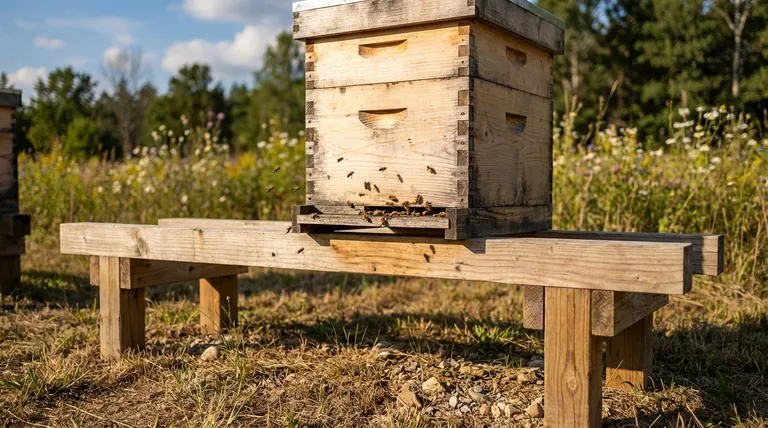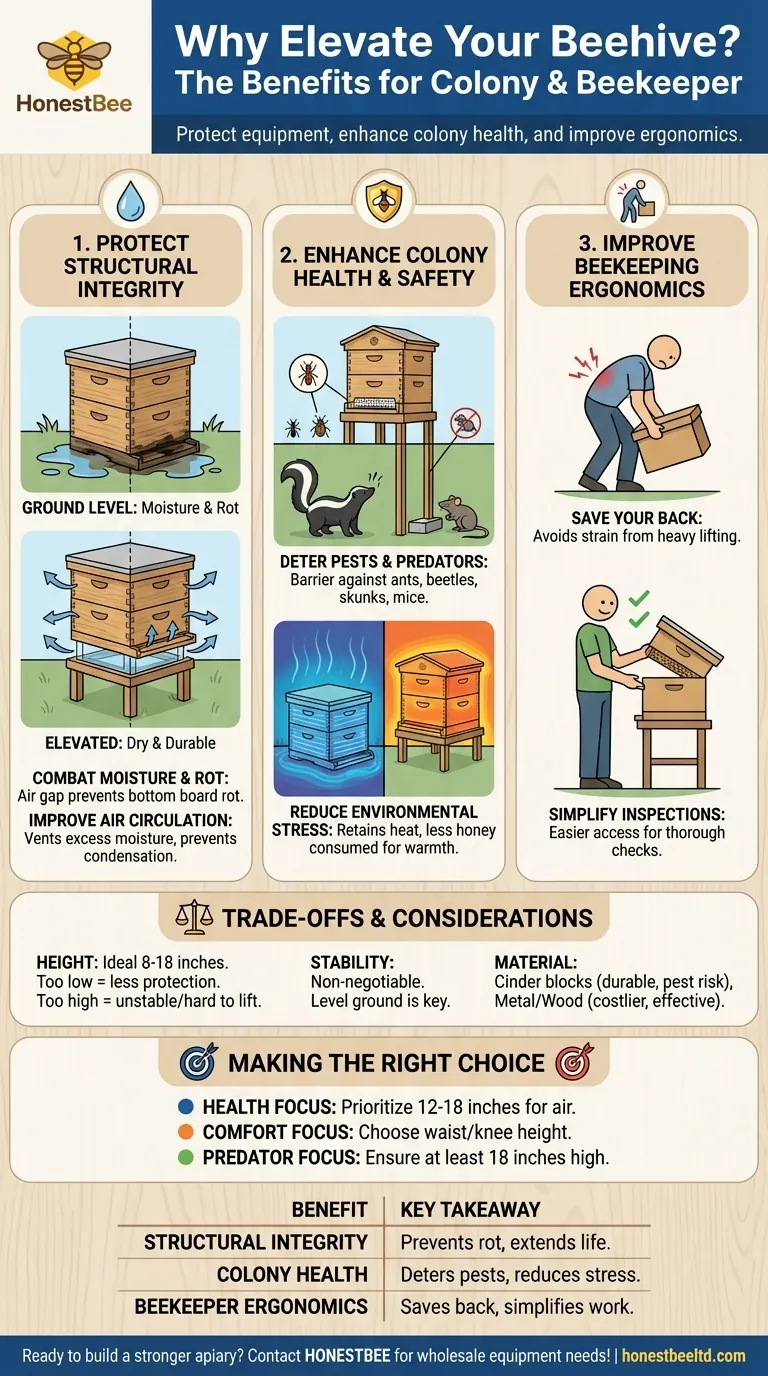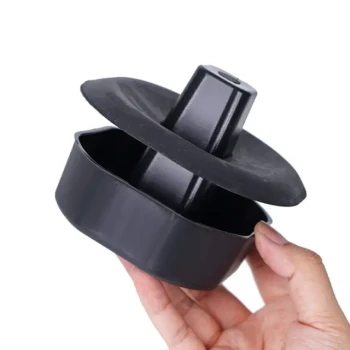Elevating your beehive is a foundational practice in modern beekeeping that provides immediate and long-term benefits. At its core, lifting a hive off the ground protects the wooden components from moisture and rot, makes inspections far easier on your back, and creates a more defensible and stable environment for the colony.
The decision to elevate a hive is not merely about convenience; it is a strategic choice to control the hive's immediate environment. By creating a buffer from the damp, unpredictable ground, you directly combat the two greatest threats to a colony's success: excess moisture and pests.

Protecting the Hive's Structural Integrity
A hive's longevity is directly tied to keeping its wooden components dry. Placing it on the ground works against this goal.
Combating Moisture and Rot
The bottom board is the foundation of your hive. When it sits directly on the ground, it constantly wicks moisture, creating the perfect conditions for fungus, mold, and wood rot.
Elevating the hive creates an air gap underneath. This simple separation is the most effective way to keep the bottom board dry, dramatically extending the life of your equipment.
Improving Air Circulation
A raised hive benefits from superior air circulation. This airflow helps vent excess moisture that the bees naturally produce through respiration.
Proper ventilation is especially critical during winter, as it helps prevent condensation from forming on the inner walls and dripping down on the cluster, which can chill and kill the bees.
Enhancing Colony Health and Safety
A dry and defensible hive is a healthy hive. Elevation gives your bees a significant advantage against environmental and biological threats.
Deterring Pests and Predators
Raising a hive creates a physical barrier against ground-level threats. Pests like ants and beetles have a harder time reaching an elevated entrance.
Furthermore, elevation is a primary defense against predators like skunks, which disturb hives at night by scratching at the entrance. A stand also makes it more difficult for mice to enter the hive seeking warmth in the fall.
Reducing Environmental Stress
A hive sitting on cold, damp ground constantly loses heat. This forces the bee cluster to consume more of their vital honey stores just to maintain their core temperature.
By keeping the hive dry, elevation helps it retain heat more efficiently. A warmer, drier colony is under less stress and is better equipped to survive winter and build up quickly in the spring.
Improving Beekeeping Ergonomics
Beekeeping involves heavy lifting, and hive placement has a major impact on the physical strain of the hobby.
Saving Your Back
A standard deep hive box full of honey can weigh over 80 pounds. Repeatedly lifting this weight from ground level is a direct path to back strain.
Elevating the hive to waist or knee height transforms the ergonomics of an inspection. It allows you to lift with your legs, not your back, making the entire process safer and more sustainable.
Simplifying Inspections
When a hive is easily accessible, you are more likely to perform regular, thorough inspections. Good ergonomics mean you can work more comfortably and carefully, making you better at spotting early signs of disease or pests.
Understanding the Trade-offs and Considerations
While beneficial, elevation requires some thought to implement correctly.
The Question of Height
The ideal height is typically between 8 and 18 inches. Too low, and you lose the benefits of moisture and pest protection. Too high, and the hive can become top-heavy and unstable in high winds, and lifting heavy honey supers becomes difficult again.
Stability is Non-Negotiable
Your hive stand must be level and absolutely stable. A wobbly hive is a danger to you and the bees. Common solutions like stacked cinder blocks or dedicated wooden or metal stands are effective as long as they are placed on firm, level ground.
Choosing Your Stand Material
Cinder blocks are inexpensive, durable, and rot-proof. However, their hollow cores can become homes for pests like ants. Commercially available metal or wooden stands are excellent but represent a greater initial cost.
Making the Right Choice for Your Goal
Your specific reason for elevating the hive can guide your setup.
- If your primary focus is colony health: Prioritize a height of at least 12-18 inches to ensure excellent air circulation and keep the hive well clear of damp ground and splashing rain.
- If your primary focus is beekeeper comfort: Choose a stand that raises the bottom of the first hive box to a comfortable working height for your body, preventing you from stooping during inspections.
- If your primary focus is predator protection: Ensure the stand is high enough (at least 18 inches) to deter skunks and is paired with an entrance reducer in the fall to block mice.
Ultimately, a simple hive stand is a foundational investment in the longevity of your equipment and the vitality of your bees.
Summary Table:
| Benefit | Key Takeaway |
|---|---|
| Structural Integrity | Prevents wood rot and extends equipment life by keeping the bottom board dry. |
| Colony Health | Deters pests (ants, skunks, mice) and reduces environmental stress on the bees. |
| Beekeeper Ergonomics | Saves your back by raising the hive to a comfortable working height for inspections. |
Ready to build a stronger, healthier apiary? The right equipment is the foundation of success. HONESTBEE supplies durable, wholesale-focused beekeeping supplies and equipment to commercial apiaries and distributors. Let us help you protect your investment and maximize your colony's potential. Contact HONESTBEE today for your commercial and wholesale equipment needs!
Visual Guide

Related Products
- Wholesales Dadant Size Wooden Bee Hives for Beekeeping
- Yellow Plastic Bucket Pail Perch for Beekeeping
- Professional Engraved Round Hive Number Tags for Beekeeping
- Assembled Wooden Bee Frames with Beeswax Foundation Ready to Use by HONESTBEE
- Professional Ant-Proof Beehive Stand with Integrated Moat for Beekeeping
People Also Ask
- What types of products are available for beekeeping needs? Essential Equipment for Apiaries & Distributors
- What is beekeeping equipment? Essential Tools for Commercial Apiaries & Distributors
- What should beginners consider when purchasing beekeeping equipment? A Guide to Essential Starter Gear
- What are the advantages of wooden bee hives? Superior Bee Health & Beekeeper Flexibility
- How often should the area under beehives be inspected and cleaned during the warm season? A Proactive Maintenance Guide



















